~
CASA MUCARO ~
Casa Mucaro is my home. It is
named for my totem
animal, the mucaro or Puerto Rican screech owl. It is only heard
after dark and is seldom seen. I hear mucaros almost every night,
but in over 35 years here I have only
seen one in silhouette at sundown. Welcome to the jungle.

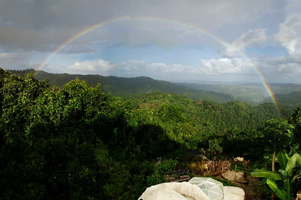
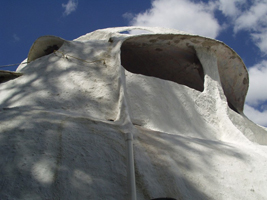
For more house photos, see the following albums:
Early House
Photos 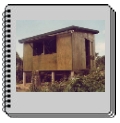
More Recent
Photos 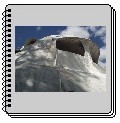
Most Recent
Photos 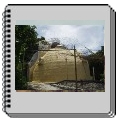
My home, Casa Mucaro, started
out about 35 years ago as a plywood cabin on stilts with a tarpaper
roof. The plywood window covers hinged up like awnings and were
held by prop sticks. The cement part of the house eventually grew
over the plywood cabin, which can still be seen in interior views
of the house.
My goals at that time were to establish fruit orchards with a variety
of foods. I liked the idea of subsistence farming, especially
since being an artist was another of my goals. The words
Poor-Starving-Artist always seem to be found together. I prefer a
life not based on money, but in reality it is very useful to
have. It frees up time for other things.
What I have done with my time is mostly house building. My
parents built their own home in California out of adobe blocks. I
was raised here, two blocks from Los Angeles International Airport.
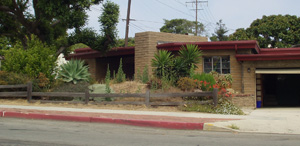
I grew up in times fascinated with dome construction, thanks mostly to
Buckminster Fuller. The only domes that didn't crack and leak at
joints were the ferro-cement domes, a technique also used in boat
building. The domed
shapes were made of rebar bent to shape and held in place by tie
wires where the rebars intersect. Three layers of chicken wire
were
traditionally used over the rebar to make a plasterable mesh .
The resulting walls are about 1
1/2 inch thick.
We have hurricanes here in Puerto Rico. The old architecture used
wood and galvanized roofing material. Most homes are now built
out of cement block walls, with thick concrete slab ceilings.
They are heavy structures and require serious foundations.
I like cement. It's termite-proof, for one thing, and you don't
destroy forests for it. I don't know how ecology-friendly the
rest of the industry is, but as a stone-like material cement has lots
of potential uses. We produce cement here on the
island. Anything that reduces outside dependency provides us with
some cushion in global hard times.
We import about 95% of our food here in Puerto Rico. Becoming
more food self-reliant as an individual helps Puerto Rico to be more
self-reliant, also. In a worst case scenario if our food imports
stopped, I think we would have sufficient panic to justifying a little
more planning now.
A flat cracker breaks more easily than a curved egg shell. Part
of that
is because complex curvature makes the rounded shape stronger than the
flat one. One can make a domed cement roof with less material
than a flat roof. The walls can be thinner. A much smaller
foundation is needed, if any foundation is needed at all. Even if
a wall is undermined, it might not crack and fall apart like a heavier
structure would.
While looking for ways to plaster the ground with a thin layer of
cement, I hit upon the idea of using nylon fishnet instead
of chicken wire as the mesh material. On the ground, fishnet
won't rust like chicken wire will,
which often destroys the cement as the rust expands. It is also a
lot more flexible than chicken wire is. Fishnet will adapt to
cover any shape carved into the ground.
One experiment led to the next and soon I was considering what I could
do with this "nylon-cement" material. Supported by rebar above
ground, it replaces chicken wire in ferro-cement construction. On
the ground, a 1/4 inch layer of nylon-cement over shapes in
carved earth can provide floors, patios, stairs, ponds, septic tanks,
and other things. Below ground it can be used to line tunnels, if
the earth permits tunneling at all. Fortunately, the ground here
proved suitable for tunneling.
Those were exciting times. I figured out how to meet many of my
survival needs thanks to nylon-cement. I even made a toilet and
hand-powered washing machine out of it. As a sculptor, building
this house has been a dream-like experience of imagining shapes and
then making them happen. The materials are flexible to meet
almost any design need.
Growth has been organic, adapting flexibly to needs. Some guiding
principles were kept in
mind, but mostly on-the-spot designing was going on all the time.
A team of men building a house from plans finishes a house in a few
days it seems and then you get to experience the house. I was
experiencing it as it slowly grew, trying it out and making changes as
I went. If the walls were too close, I untied the wires and
reshaped the rods. I found where I needed to hang tools and made
rings for hanging things built into the structure of the house.
If things are in the way, you can always hang them from the ceiling.
Eventually, the structure was ready for plastering. The water
content of the mix is important. Different jobs call for
different consistencies.
At first, I used a technique I no longer use. Trying to
imitate chicken wire, I soaked pieces of fishnet in cement and
water. Working in late afternoon, I put it in buckets, climbed
the structure, and
draped it on the rod structure of the house like wet clothes to
dry. It rigidified like chicken wire by morning. Toward the
center of the domed roof, I used temporary bamboo columns from the
ground to support me and the weight of the cement.
Plastering was done from the ground up. The outside was plastered
as high as I could reach on the first day. The inside of that was
plastered the next day. On the third day, I stood on a drum
outside and reached higher up. Alternating inside and outside
days for plastering, I eventually reached the center of the dome.
The house is a cluster of domes, kind of like soap suds. That was
my model in those days, a sort of organic
cellular growth. Today, extending my architectural vision into
city construction, I also see termite nests as being useful
models.
House construction has had a very good side benefit to me in that it
kept my body well exercised. A sedentary lifestile leads to
various health problems. A comunity of builders would have a bit
of health insurance built into their lifestyle. If children were
taught to build their own schools, they would certainly be competent
builders by the time they graduated. They would also be more
self-sufficient as adults in terms of producing things they need.
The tuna factory that was my source of used fishnet has moved somewhere
where labor is cheaper, so free fishnet is no longer available to
me. That seems to be timing out nicely, because I'm about 60 now
anyway, and it seems reasonable to retire sometime. The
guesthouse I am working on now may be the last major construction I
build myself. I have big dreams, though, so future consulting is
not out of the question.
I see the keys to success here as being tools, materials, and
knowhow. Learn all you can. Practice it.
Click here for more information about nylon-cement.
Click here for more information about a simple technique for painting
rebar and getting
better longevity for your construction.



